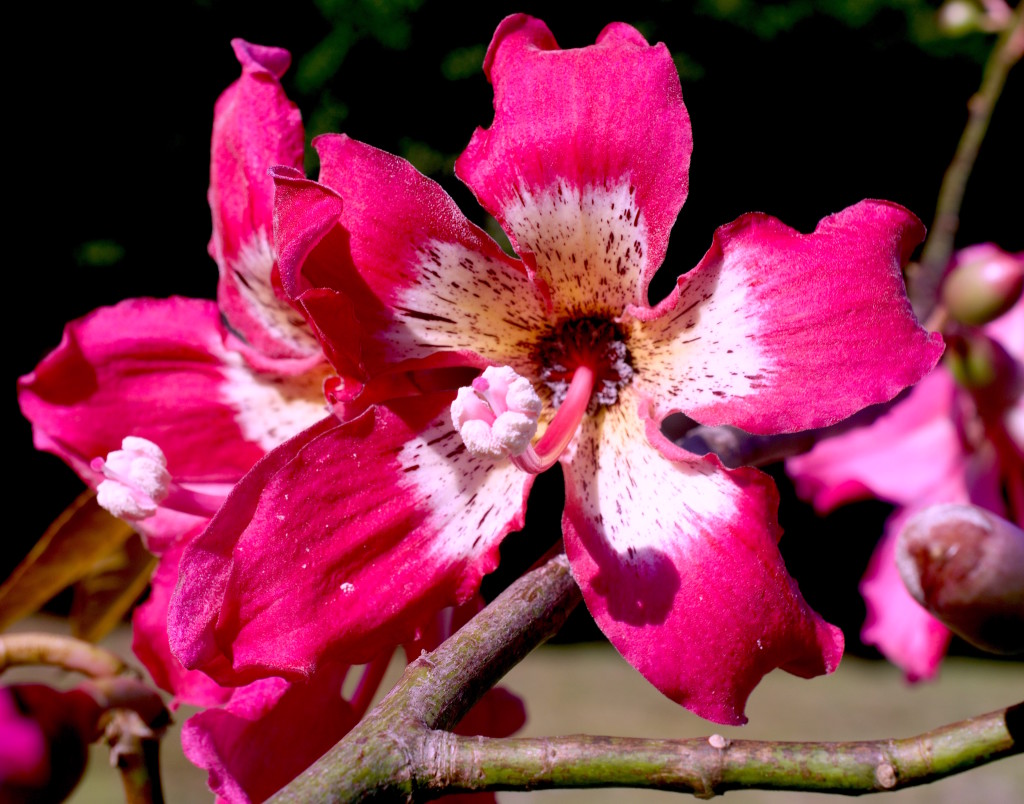
Resembling a Hibiscus blossom, a young Ceiba tree blossoms in Orlando but it might be doomed to die in the winter chill. Photo by Green Deane
What people actually do with plants and what people write about what people do with plants can vary greatly. Ceiba’s (SAY-bah) are a good example. There are ten trees in the tropical genus. Various parts of various species are eaten variously which makes sense as the greater Mallow Family is generally user-friendly (unprocessed cotton seed oil and ephedrine in Sida being two exceptions.) Thus it is difficult to state specifically what is edible on each species Ceiba. The names can also vary in English from Silk Cotton to Kapok and numerous native and Spanish versions. The seed oil is edible on some species as are buds, blossoms, and young leaves on others. Even the wood ash can be used as a salt substitute. But some caution is called for as the trees have also been used to treat numerous medical conditions internally and externally. There are two species in Dreher Park in West Palm Beach where the winters are mild. I’ve seen two Ceibas planted in Orlando but they are only a few years old and not two yards apart, close for trees that can grow over 100 feet. Whether they will weather the ever-cooling winters is questionable. I am guessing the Ceiba pictured above is perhaps C. speciosa, the Silk Floss Tree, which was my original guess. A reader helped ID it (thanks A.C.) You can read a little more about it here.
Experience sometimes can get in the way of foraging. It happened to me recently in Gainesville. Foraging is very much about context: Right plant, right place, right time. We were looking for wild cucumbers when a lad who came with his father found a red berry on a vine. My mind immediately popped up a botanical name, Mitchella repens. But a red flag went up immediately as well. Despite decades of foraging in Florida I’ve never seen the “Partridgeberry” in Florida. I usually see it in August in western North Carolina or eastern Tennessee.
As one might expect this Partridgeberry was not as robust as its kin farther north. The vine was thinner and the leaves not as dark green. But the configuration was right and more importantly the berry was right. This species produces two ovaries that fuse together so one berry has two blossoms. I could see the remains of that on the berry, a prime identification characteristic. The berries are edible if not a bit bland. But it’s a new one to add to my local edibles list. And botanical maps do put it in many counties in the state. So the Partridgeberry was the right plant in the right place at the right time but I was also right in waiting until I got some confirmation from my foraging pals (thanks Josey.) I wanted to make sure they were seeing what I was seeing. It never hurts to ask. To read more about the Partridgeberry go here.
In Gainesville and Ocala recently I saw several bunches of Ringless Honey Mushrooms. The location was not usual per se but the time of year is slightly off. While locally Ringless Honey Mushrooms can be found any month of the year, they usually favor the fall if not the early winter. Locally I expect to see them in mid-November. But they have been popping up all over the place a bit north of here as reported on three mushroom pages I have on Facebook: Florida Mushroom Identification Forum, Southeastern US Mushroom Identification, and, Edible Mushrooms: Florida. I even found “Honeys” growing on a Banyan Root in West Palm Beach in July, most out of character.
Opinions on Ringless Honey Mushrooms vary, some call them not edible (as does David Spahr, a mushroom expert and author in Maine.) A mushroom expert and author in Florida, Dr. James Kimbrough, calls them good. Some people eat only the caps, some eat the entire mushroom. Some parboil them first. Interestingly Ringless Honey Mushrooms were being sold for high prices this past weekend in a farmer’s market in Deland. My main hesitation regarding “Honeys” is what wood they are growing on. As they are intimately associated with the wood this worries me. In Gainesville one stump they were growing on was a Cherry Laurel, which is a laced with a chemical that upon digestion releases cyanide. I’ve also seen them growing on toxic Azaleas. I think I would also pass “Honeys” growing on a Juniper stump just because they might not taste that good. Ringless Honey Mushrooms on a Banyan roots would probably be all right as they are related to figs.
There are several main identifying characteristics of the Ringless Honey Mushroom to look for: They are cespitose, which means all growing from one point, they grow on wood, they have a white spore print — that’s extremely important — and they don’t have a fleshy ring around the stem. I would add I also saw a fall flush of Chanterelles in Gainesville and a few edible Boletes and Lactarii in Ocala. To read more about the Ringless Honey Mushroom go here.
The other little mystery of two recent classes was whether the leaf I was examining belonged to a young Persia borbonia (Red Bay) or Magnolia virginiana (Sweet Bay) or even a Magnolia grandiflora. Identification is usually not an issue as the adult leaves are quite distinct as are their scents. But younger leaves like some younger kids have no-yet committed features. Also it is rare to see a large Red Bay as they are dying by the thousands of a disease. The Red Bays have hair on the stem that is helped to ID them but the hair was sparse on the examples I had. Worse they had a little underleaf bloom that rubbed off. The Sweet Bay leaf is white on the bottom and the white rubs off. I finally decided in each case I had a Red Bay leaf because the underside was not white enough and the stem did have a little bit of hair. Some times distinct species can hide their identity. You can read more about the “bays” here.
Incidentally that “disease” is Laurel Wilt, Raffaelea lauricola. It was introduced by an Asian beetle, Xyleborus glabratus, in 2002. The wilt is creeping its way southward from ground zero which was Savannah, Georgia. As one might expect Laurel Wilt is killing trees in the Laurel family including Red Bays, Swamp Bays, Sassafras, and Camphors — but not the Laurel Cherry which is in a different family. The wilt’s other target is avocados which explains why my avocado tree died a couple of years ago. It has killed approximately 7,000 commercial avocado trees in south Florida. Avocados were a $30 million business in the state in 2011 but has dropped down to just over $24 million. The infestation could also destroy 30% of the native trees in Florida with half a billion trees already dead. This also has impact on birds and animals dependent on those species. Lastly, what is a common vector for the beetle, that is, how does it get spread around? By people bringing infected firewood from home to burn on recreational trips.
The seasons are changing but they are also stretching. There have been several comments here about plants being found out of season (such as Ringless Honey Mushrooms in West Palm Beach in June.) Last year I wrote about finding Pellitory in July when it is usually gone by late spring. I start looking for Pellitory about six weeks from now but it found me in Jacksonville this past weekend. A sharp-eyed student in my foraging class asked what a small plants was. No doubt that it was Pellitory aka Cucumber Weed. There was only a small stand of it, and only a few inches high but there it was making an early-season debut. It demonstrates that foraging is not a static endeavor but always changing a little. Often it’s a botanical name change, sometimes a new edible ornamental. But seasonal changes are also possible requiring some alteration to the memory banks. Read more about Pellitory here.
Upcoming foraging classes: This weekends class is in West Palm Beach and should be nice as the weather has cooled some. While there is some plant overlap from more northern areas of the state the mild winters in West Palm allows more tropical species to thrive and includes plants found down to at least the keys.
Sunday, Oct. 25th, Dreher Park, 1200 Southern Blvd., West Palm Beach, 33405, 9 a.m.
Sunday, Nov. 1st, Bayshore Live Oak Park, 23000 Bayshore Rd., Port Charlotte, FL 33980, 9 a.m.
Sunday, Nov. 8th, John Chestnut County Park: 2200 East Lake Road, Palm Harbor, FL 34685, 9 a.m.
Sunday, Nov. 15, Mead Garden,1500 S. Denning Dr., Winter Park, FL 32789, 9 a.m.
Sunday, Nov. 22nd, Red Bug Slough Preserve, 5200 Beneva Road, Sarasota, FL, 34233, 9 a.m.
To learn more about the classes go here.
Want to identify a plant? Perhaps you’re looking for a foraging reference? You might have a UFO, an Unidentified Flowering Object, you want identified. On the Green Deane Forum we — including Green Deane and others from around the world — chat about foraging all year. And it’s not just about warm-weather plants or just North American flora. Many nations share common weeds so there’s a lot to talk about. There’s also more than weeds. The reference section has information for foraging around the world. There are also articles on food preservation, and forgotten skills from making bows to fermenting food. Recent topics include: Preserving Prickly Pear Bounty. When I was Five Years Old. Bearberry. Shrub? Zanthoxylum Americanum or something else? Lawn Weed. Tea, Salt and Amia. An Odd Pine, Guini Wasps, Vine? 3 TX UFO’s, Shrub In High Desert, The Power of Play, Pandanus candelabrum, and Rainforest UFO. You can join the forum by clicking on the button on the upper right hand side of this page.
All of Green Deane’s videos are available for free on You Tube. They do have ads on them so every time you watch a Green Deane video I get a quarter of one cent. Four views, one cent. Not exactly a large money maker but it helps pays for the newsletter. If you want to see the videos without ads and some in slightly better quality you can order the DVD set. It is nine DVDs with 15 videos on each. Many people want their own copy of the videos or they have a slow service and its easier to order then to watch them on-line. They make a good Christmas or birthday gift. Individual videos can also be ordered. You can order them by clicking on the button on the top right of this page or you can go here.
This is weekly newsletter 179.There was no newsletter last week because on publication day the site disappeared and it took a while to restore it with a back up. Although one would not think so the site receives several thousand hack attempts daily. Sometimes that causes issues.
To donate to the Green Deane Newsletter click here.

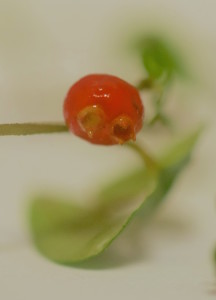
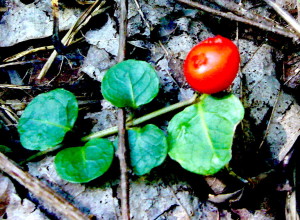
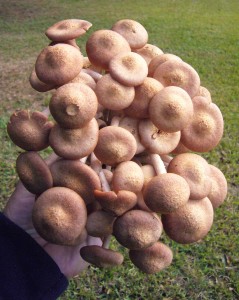
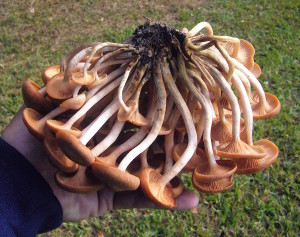
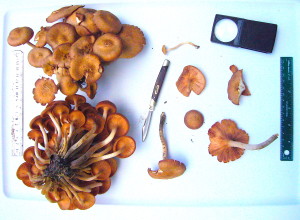
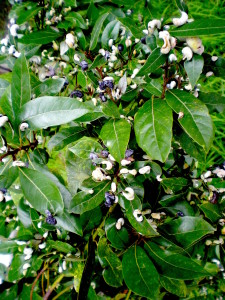
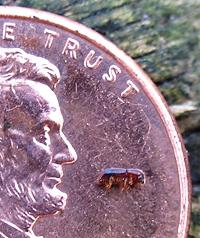
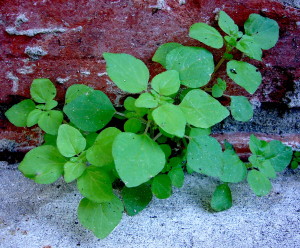
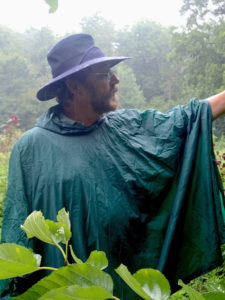
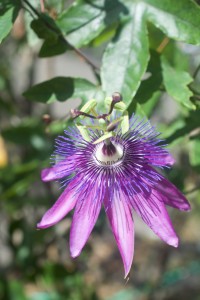


Greetings, sir!
I believe the picture above is a flower of the Ceiba speciosa / Floss silk tree. There are two huge trees in a Conway area neighborhood near OIA. I also have a nice size one in the yard as well. All of these trees fair very well year-round and are in bloom now.
Thank you for all the information that you share.
Thanks. It very well could be. Kind of hard to find cool weather information.
Keep up the good work, Deane! Great newsletter, as usual.
Indeed the seasons are changing. Here in Khartoum we won’t expect to have heavy rainfall after mid October like what we had last week. Moreover last night (24th Oct.) it was roaring with some rain. I’ve got a plant in my garden for which I may suggest the name Pellitory aka – Cucumberweed. I was looking at images like those on Eattheweeds and elsewhere. However, not having pink or red stem or branches, and though not being sure of its leaves being toothed, I resolved to your suggestion to call it Acalypha. I’m hoping to send you an image of this weed as soon as I can.
Now, one of the advantages of “Eattheweeds” is widening scope of knowledge while feeling joyful as I may show with the following example during investigating the identity of my weed. If you won’t mind I should like your honourable readers to share the pleasure of “foraging” with C.S. Lewis’ poem about Addison’s Walk a mile – long circuit round the deer park at Magdalen (Magdalen College, Oxford University, UK) which Lewis traversed frequently with his students and friends. I think it has much to do with foraging and love of nature. It starts with: “ What the bird said early in the year “ Please google: What The Bird Said Early in The Year by C.S. Lewis | Laodica. “